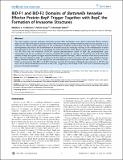| dc.contributor.author | Truttmann, Matthias C. | |
| dc.contributor.author | Guye, Patrick | |
| dc.contributor.author | Dehio, Christoph | |
| dc.date.accessioned | 2012-02-15T18:12:27Z | |
| dc.date.available | 2012-02-15T18:12:27Z | |
| dc.date.issued | 2011-10 | |
| dc.date.submitted | 2011-07 | |
| dc.identifier.issn | 1932-6203 | |
| dc.identifier.uri | http://hdl.handle.net/1721.1/69112 | |
| dc.description.abstract | The gram-negative, zoonotic pathogen Bartonella henselae (Bhe) translocates seven distinct Bartonella effector proteins (Beps) via the VirB/VirD4 type IV secretion system (T4SS) into human cells, thereby interfering with host cell signaling [1], [2]. In particular, the effector protein BepG alone or the combination of effector proteins BepC and BepF trigger massive F-actin rearrangements that lead to the establishment of invasome structures eventually resulting in the internalization of entire Bhe aggregates [2], [3]. In this report, we investigate the molecular function of the effector protein BepF in the eukaryotic host cell. We show that the N-terminal [E/T]PLYAT tyrosine phosphorylation motifs of BepF get phosphorylated upon translocation but do not contribute to invasome-mediated Bhe uptake. In contrast, we found that two of the three BID domains of BepF are capable to trigger invasome formation together with BepC, while a mutation of the WxxxE motif of the BID-F1 domain inhibited its ability to contribute to the formation of invasome structures. Next, we show that BepF function during invasome formation can be replaced by the over-expression of constitutive-active Rho GTPases Rac1 or Cdc42. Finally we demonstrate that BID-F1 and BID-F2 domains promote the formation of filopodia-like extensions in NIH 3T3 and HeLa cells as well as membrane protrusions in HeLa cells, suggesting a role for BepF in Rac1 and Cdc42 activation during the process of invasome formation. | en_US |
| dc.description.sponsorship | Swiss National Science Foundation (grant 31003A-132979) | en_US |
| dc.description.sponsorship | Howard Hughes Medical Institute (grant 5500550) | en_US |
| dc.description.sponsorship | Swiss Initiative for Systems Biology (grant 51RT-0_126008 (InfectX)) | en_US |
| dc.language.iso | en_US | |
| dc.publisher | Public Library of Science | en_US |
| dc.relation.isversionof | http://dx.doi.org/10.1371/journal.pone.0025106 | en_US |
| dc.rights | Creative Commons Attribution | en_US |
| dc.rights.uri | http://creativecommons.org/licenses/by/2.5/ | en_US |
| dc.source | PLoS | en_US |
| dc.title | BID-F1 and BID-F2 Domains of Bartonella henselae Effector Protein BepF Trigger Together with BepC the Formation of Invasome Structures | en_US |
| dc.type | Article | en_US |
| dc.identifier.citation | Truttmann, Matthias C., Patrick Guye, and Christoph Dehio. “BID-F1 and BID-F2 Domains of Bartonella Henselae Effector Protein BepF Trigger Together with BepC the Formation of Invasome Structures.” Ed. Dipshikha Chakravortty. PLoS ONE 6.10 (2011): e25106. Web. 15 Feb. 2012. | en_US |
| dc.contributor.department | Massachusetts Institute of Technology. Department of Biological Engineering | en_US |
| dc.contributor.approver | Guye, Patrick | |
| dc.contributor.mitauthor | Guye, Patrick | |
| dc.relation.journal | PLoS ONE | en_US |
| dc.eprint.version | Final published version | en_US |
| dc.type.uri | http://purl.org/eprint/type/JournalArticle | en_US |
| eprint.status | http://purl.org/eprint/status/PeerReviewed | en_US |
| dspace.orderedauthors | Truttmann, Matthias C.; Guye, Patrick; Dehio, Christoph | en |
| mit.license | PUBLISHER_CC | en_US |
| mit.metadata.status | Complete | |
